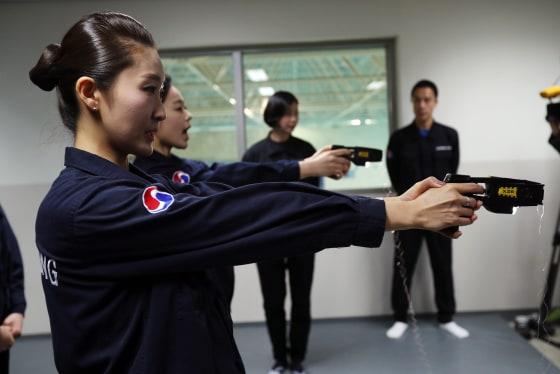Table of Contents
- Understanding Stun Gun Mechanisms and Safety Features
- Proper Grip and Handling Techniques for Effective Use
- Situational Awareness and Legal Considerations for Women
- Routine Practice Drills to Build Confidence and Reaction Speed
- To Wrap It Up
Understanding Stun Gun Mechanisms and Safety Features
Stun guns operate by delivering a high-voltage, low-amperage electrical shock designed to temporarily incapacitate an attacker. At the core, most stun guns use a transformer to step up the voltage from the battery to tens of thousands of volts, enough to disrupt the muscle functions and nerve signals of the target without causing permanent injury. Understanding this mechanism is crucial because it highlights why the device should never be used carelessly or without proper training. Knowing how long to apply the shock and the appropriate distances can significantly affect not only the device’s effectiveness but also personal safety.
Modern stun guns often incorporate several safety features to reduce the risk of accidental discharge and ensure user protection. Common safety components include:
- Safety switches or triggers that prevent accidental activation
- LED indicators showing when the device is armed and ready
- Lightweight, ergonomic designs that improve grip and control
- Automatic shutoff functions limiting the duration of the electrical output
Proper Grip and Handling Techniques for Effective Use
Mastering the correct grip is crucial for maximizing both safety and effectiveness when using a stun gun. Hold the device firmly in your dominant hand, ensuring your fingers wrap securely around the handle with your thumb aligned along the side, ready to activate the trigger. This grip prevents unwanted slips and ensures immediate response if defense becomes necessary. Additionally, keeping your wrist steady and your arm positioned at a 90-degree angle allows for greater control and stability, significantly reducing the risk of accidental discharge or loss of the device during an encounter.
When handling your stun gun, always keep these critical points in mind:
- Maintain awareness: Keep your stun gun visible but non-threatening until the moment you need to use it.
- Practice smooth activation: Familiarize yourself with the trigger to enable quick, confident deployment under stress.
- Keep a safe stance: Position yourself with legs shoulder-width apart to maintain balance and readiness.
- Never handle when fatigued: Your grip strength and reaction time must be at their best to ensure safety.
Incorporating these techniques into your regular safety practice sessions develops muscle memory that is invaluable during real-life situations. Confidence in your grip and handling not only enhances your protective capabilities but also empowers you to react decisively and effectively.
Situational Awareness and Legal Considerations for Women
Understanding your environment at all times is crucial when carrying a stun gun. Developing heightened situational awareness enables you to anticipate potential threats before they escalate. Always stay alert to the behavior of people around you, avoid isolated or poorly lit areas, and trust your instincts. When practicing situational awareness, consider incorporating habits such as:
- Scanning your surroundings regularly
- Identifying possible escape routes
- Noticing suspicious behavior patterns early
- Keeping your stun gun accessible but discreet
Equally important is understanding the legal landscape of stun gun possession and use in your jurisdiction. Laws vary widely, and ignorance can lead to severe consequences even when acting in self-defense. Make it a priority to:
- Research local statutes regarding stun gun ownership
- Know where you are legally allowed to carry it (public vs. private property)
- Understand situations that legally justify its use
- Consult local law enforcement or legal counsel for clarity
Being informed empowers you to protect yourself responsibly while respecting the law, creating a safer environment for you and those around you.
Routine Practice Drills to Build Confidence and Reaction Speed
Incorporating consistent training drills into your routine is crucial for developing the sharp instincts needed to operate a stun gun confidently. Start with simple reaction exercises, such as practicing quick draw techniques in front of a mirror, which help ingrain muscle memory. You can enhance this further by using timing drills where a partner signals unpredictable moments for you to respond, sharpening your reflexes under pressure. Focus on controlled, deliberate movements rather than speed alone to ensure correct handling every time.
To maintain progress, integrate a mix of physical and mental preparation through activities like:
- Shadow drills: Simulate defense scenarios to build situational awareness and fluid responses.
- Grip strengthening exercises: Enhance control and reduce the risk of dropping your device when seconds count.
- Mindfulness and stress management techniques: Stay calm under duress, increasing your ability to react quickly without panic.
Consistency is key-dedicate time each week to practicing these drills, and you’ll find your confidence and reaction speed improving markedly, making defensive actions instinctive when faced with real threats.
To Wrap It Up
Incorporating stun guns into your personal safety routine can be empowering, but proper training is essential to use them effectively and responsibly. By following the tips outlined above-practicing regularly, understanding the device, prioritizing safety, and staying informed-you’ll build the confidence needed to protect yourself if the situation ever arises. Remember, a stun gun is just one tool in your safety arsenal; staying aware and prepared remains your best defense. Stay safe, train smart, and take control of your personal security with confidence.Check Our Other Blogs
- StunGun – Your Trusted Source for Stun Guns, Laws, and Self-Defense Tips
- PepperSprayLaws – Your Trusted Resource for Pepper Spray Information
- StunGunLaws – Your Trusted Guide to Stun Gun Legality and Safety





